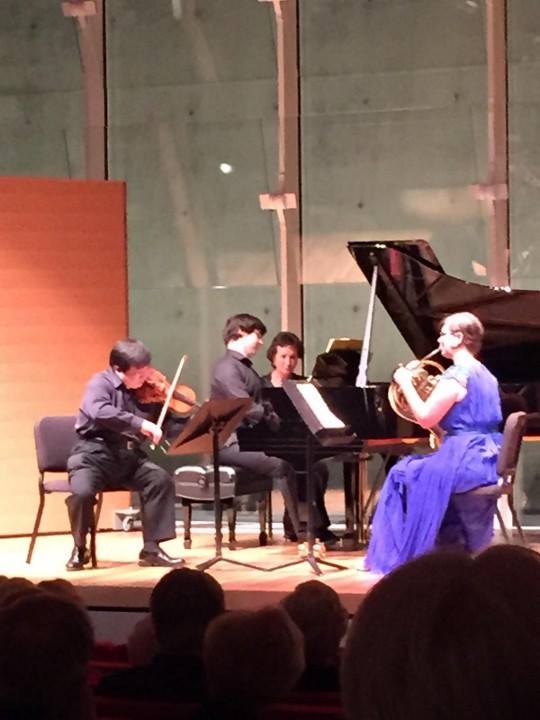Developing a unique and masterful voice is among the highest artistic achievements for any musician. In the light instrumentation of chamber music, though, the individual personalities of the musicians must be balanced against the intent of the composer. Walking this fine line Thursday night were several heavyweights from the Fort Worth Symphony Orchestra and Cliburn gold medalist Vadym Kholodenko in a memorable night at the Kimbell Art Museum’s Piano Pavilion.
The pavilion’s performance hall is as visually delicious as it is acoustically impeccable and served as the perfect venue for the intimate concert. The evening’s large crowd consisted mainly of regulars to events by the Chamber Music Society of Fort Worth, FWSO, and Cliburn.
FWSO vice president of artistic administration, Erik Finley opened the evening with a brief introduction. He quickly got to the point, addressing what was probably on most audience member’s minds: Why program two of the three works by the same composer? The reason, he said, is that all three works were innovative for their time and became much beloved over the decades.
The opening work was a trio for clarinet, piano, and cello by Brahms. The work (opus 114) is a late masterpiece of the romantic composer. Clarinetist Ana Victoria Luperi, cellist Allan Steele, and Kholodenko hit their stride straight of the gate. Throughout the first movement, the pianist took a light touch, emphasizing the melody while keeping his left hand accompaniments in the background. Steele and Luperi, who had many runs in parallel, kept each note in near-perfect tune with each other. The second movement, a serenade of sorts, had cello and clarinet alternating luscious melodies in imitation of and in harmony with one another. (A music scholar and close friend of Brahm’s, Eusebius Mandyczewski, made a singularly prescient observation when he noted that the work, as a whole, sounds “as though the instruments were in love with each other.”) It was in the fourth and final movement when Kholodenko finally let loose, exploding at moments and giving the piece a pyrotechnic finale that contrasted sharply with the more subdued preceding passages.
The Poulenc trio for bassoon, oboe, and piano offered an “auditory sorbet” of sorts, said bassoonist Kevin Hall in his introduction to the evening’s second work. Unlike the previous pairing of clarinet and cello, the bassoon and oboe share a similar timbre, although the bassoon performs far lower in pitch for the most part. The similarity makes for a sonorous blending of color when the woodwinds play in unison and harmony, but the pairing can also leave the two instruments in perilous danger of losing their distinct identities. Partly due to the crafty writing of the French composer (who kept the two instruments an octave or more apart) and partly to the skill of Hall and oboist Jennifer Lucio, the works came off as Poulenc must have wished, a humorous and lively patchwork of scènes musicales. Matching Lucio and Hall in color and agility was Kholodenko, whose intense focus never faltered throughout the evening.
After a lengthy intermission, the program concluded with the most popular work on the program, Brahms’ trio for violin, horn, and piano. Commonly known as “The Horn Trio,” this deeply personal work was composed in 1865 in remembrance of the composer’s mother, who had recently died.
The first movement was given an orchestral treatment with long, arching phrases carefully crafted (and coordinated among the three instruments) to swell in crescendos that took minutes to unfold. The scherzo second movement left violinist Michael Shih fighting to be heard against the thunderous barrage of piano and horn during louder passages. The three found their balance again in the third movement as French hornist Kelly Cornell and Shih traded beautifully languid melodies against Kholodenko’s pianissimo strumming.
The concert ended with thunderous applause as Kholodenko and his compatriots took numerous curtain calls. The performances were supremely tight, the musicians clearly having taken full advantage of their opportunity to rehearse together for four days. What was missing was a program that highlighted the artistry of a virtuoso still new to Fort Worth audiences, Kholodenko. Rather than use a series of trios, which often relegate the piano to an accompanimental role, a sonata by Prokofiev or Rachmaninoff, for example, would have given the pianist many more moments to shine.
Thursday’s concert was the first of many collaborations planned as part of a three-year artistic partnership between Kholodenko and the FWSO. Future joint events will engage Kholodenko as soloist for all five of Prokofiev’s piano concertos (to be released under the Harmonia Mundi label) next year and a tour of Spain with the FWSO in May 2016.
Beyond being a great program of beloved classical music, Thursday’s event highlighted the world-class talent that has been nurtured and supported in Fort Worth. Even as little as 10 years ago, the local pool of classical musicians wouldn’t have been able to put on a program quite like this.














